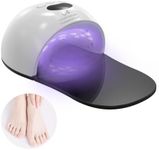Buying Guide for the Best Treatment For Nail Fungus
When choosing a treatment for nail fungus, it's important to understand the different options available and how they work. Nail fungus can be persistent and difficult to treat, so selecting the right treatment is crucial for effective results. Consider the severity of your condition, your lifestyle, and any potential allergies or sensitivities you may have. Consulting with a healthcare professional can also provide guidance tailored to your specific needs.Type of TreatmentNail fungus treatments come in various forms, including topical solutions, oral medications, and laser treatments. Topical solutions are applied directly to the nail and are often used for mild to moderate cases. Oral medications are systemic and can be more effective for severe infections but may have more side effects. Laser treatments are a newer option that uses light to target the fungus and can be effective but are often more expensive. Consider the severity of your infection and your personal preferences when choosing a treatment type.
Active IngredientsThe active ingredient in a nail fungus treatment is what targets and kills the fungus. Common active ingredients in topical treatments include terbinafine, ciclopirox, and amorolfine. These ingredients work by disrupting the cell membrane of the fungus, preventing it from growing. When choosing a treatment, look for one with an active ingredient that is known to be effective against the type of fungus you have. If you're unsure, a healthcare professional can help you identify the most suitable option.
Application MethodThe method of application can vary between treatments. Topical treatments may come as creams, ointments, or nail lacquers, each with different application instructions. Some require daily application, while others may be used weekly. Oral medications are typically taken daily and require a prescription. Laser treatments are performed in a clinical setting and may require multiple sessions. Consider your lifestyle and how much time you can dedicate to treatment when choosing the application method.
Treatment DurationThe duration of treatment can vary significantly depending on the type of treatment and the severity of the infection. Topical treatments may need to be used for several months, while oral medications are often prescribed for a few weeks to several months. Laser treatments may require multiple sessions over a few months. It's important to follow the recommended treatment duration to ensure the fungus is fully eradicated. Consider how long you're willing to commit to treatment when making your choice.
Side EffectsDifferent treatments come with varying side effects. Topical treatments generally have fewer side effects, but some people may experience skin irritation. Oral medications can have more serious side effects, including liver damage and interactions with other medications. Laser treatments typically have minimal side effects, but some people may experience discomfort during the procedure. Consider your health history and any potential risks when evaluating side effects.
EfficacyThe effectiveness of a treatment can depend on several factors, including the type of fungus and the severity of the infection. Some treatments may work faster or be more effective than others. It's important to have realistic expectations and understand that nail fungus can be difficult to treat. Research the success rates of different treatments and consider consulting with a healthcare professional to determine the most effective option for your specific case.
















